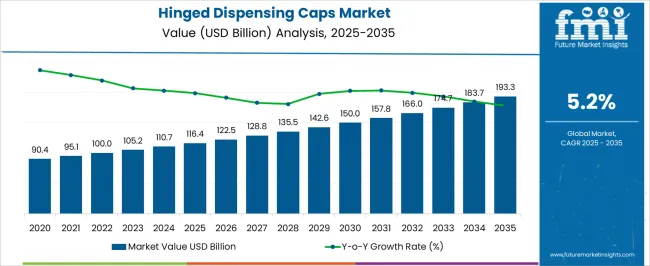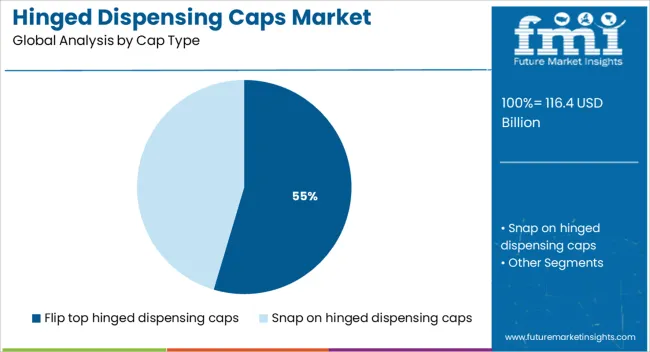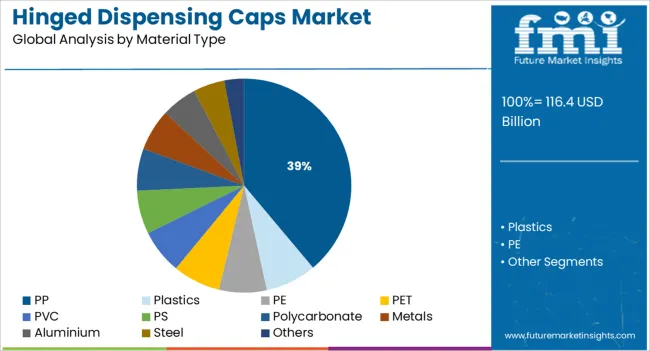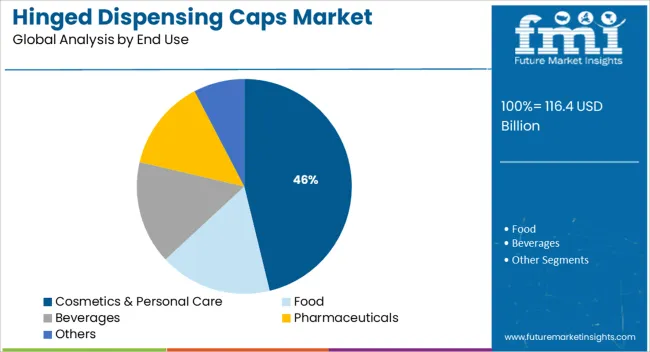The Hinged Dispensing Caps Market is estimated to be valued at USD 116.4 billion in 2025 and is projected to reach USD 193.3 billion by 2035, registering a compound annual growth rate (CAGR) of 5.2% over the forecast period.

| Metric | Value |
|---|---|
| Hinged Dispensing Caps Market Estimated Value in (2025E) | USD 116.4 billion |
| Hinged Dispensing Caps Market Forecast Value in (2035F) | USD 193.3 billion |
| Forecast CAGR (2025 to 2035) | 5.2% |
The hinged dispensing caps market is experiencing notable growth as industries prioritize functional packaging solutions that enhance product usability and safety. These caps are increasingly replacing traditional closures due to their ergonomic design and ease of single-handed operation, which aligns well with fast-paced consumer lifestyles.
The incorporation of secure sealing mechanisms and controlled dispensing features has accelerated their adoption across sectors such as cosmetics, personal care, pharmaceuticals, and food. Manufacturers are leveraging innovations in injection molding and recyclable materials to develop lightweight yet durable hinged dispensing systems that support sustainability mandates and reduce plastic usage.
Additionally, increased demand for travel-friendly and contamination-resistant packaging formats has further expanded the market’s footprint in the premium consumer goods segment As regulatory emphasis on packaging hygiene intensifies and consumer expectations evolve toward personalized and smart packaging experiences, hinged dispensing caps are expected to play a central role in next-generation packaging systems, particularly in high-growth markets across Asia-Pacific and Latin America.
The market is segmented by Cap Type, Material Type, and End Use and region. By Cap Type, the market is divided into Flip top hinged dispensing caps and Snap on hinged dispensing caps. In terms of Material Type, the market is classified into PP, Plastics, PE, PET, PVC, PS, Polycarbonate, Metals, Aluminium, Steel, and Others. Based on End Use, the market is segmented into Cosmetics & Personal Care, Food, Beverages, Pharmaceuticals, and Others. Regionally, the market is classified into North America, Latin America, Western Europe, Eastern Europe, Balkan & Baltic Countries, Russia & Belarus, Central Asia, East Asia, South Asia & Pacific, and the Middle East & Africa.

Flip top hinged dispensing caps are expected to capture 54.6% of the hinged dispensing caps market revenue in 2025, establishing their position as the dominant cap type. Their leading market share is being driven by superior consumer convenience, resealability, and precise product control during dispensing. The popularity of these caps has increased significantly due to their compatibility with a wide range of viscosities, enabling effective use in products such as shampoos, lotions, sauces, and sanitizers.
Their flip-action mechanism minimizes leakage and enhances portability, making them ideal for both on-the-go and home-use formats. The rising adoption in personal care and home care products has reinforced their market position, supported by continuous innovation in hinge design and snap-fit functionality.
Manufacturers have also favored flip top designs for their ability to support tamper-evidence and child-resistance features, aligning with safety and compliance requirements Their cost-effectiveness in mass production and compatibility with automated filling lines have made them an industry standard across multiple packaging environments.

PP is anticipated to account for 38.9% of the hinged dispensing caps market by 2025, making it the most widely used material type. The preference for PP material is being driven by its excellent chemical resistance, durability, and recyclability, which align with the operational and environmental demands of modern packaging applications. PP-based hinged caps are extensively utilized in products that require long shelf-life and compatibility with both aqueous and oily formulations, such as personal care liquids and food condiments.
Its lightweight nature and thermal stability support high-speed manufacturing processes while maintaining structural integrity under varying temperatures and pressures. The growing adoption of mono-material packaging systems for improved recyclability has further encouraged the use of PP in dispensing caps.
In addition, PP allows for seamless color customization and surface finish variations, offering brand differentiation opportunities for manufacturers Its regulatory compliance with food-grade and cosmetic standards has solidified its position as the material of choice across high-volume commercial production.

The cosmetics and personal care segment is projected to represent 46.2% of the overall hinged dispensing caps market revenue in 2025, reflecting its dominant end-use share. The demand for precision dispensing, hygiene assurance, and aesthetic packaging in this sector has significantly influenced the adoption of hinged caps. These caps offer consumer-friendly functionality that supports controlled dosing and ease of use, which are critical in skincare, haircare, and grooming products.
The growing shift toward travel-sized packaging, single-handed application, and refillable solutions has aligned well with the capabilities of hinged dispensing caps. Cosmetic and personal care brands are increasingly investing in packaging that enhances user experience while maintaining product integrity, making hinged caps a natural fit.
Additionally, as consumers seek premium packaging designs that blend convenience with sustainability, hinged dispensing caps made from recyclable polymers have gained traction The expanding global beauty industry, along with increased product launches and personalization trends, continues to reinforce the prominence of hinged dispensing caps in this application segment.
Convenience to the consumer has been the top priority of packaging manufacturers all over the globe. New formats of caps & closures are being introduced in the market, the hinged dispensing cap being one of them. Hinged dispensing cap market is expected to be driven by the demand for added value and premium products.
The soaring demand for plastic caps and closures in the beverages sector is allowing the overall hinged dispensing caps market to gain impetus. The spiraling use of PET-based disposable bottles is translating into the greater sales of hinged dispensing caps.
Also, higher levels of R&D investment and technical expertise are expected to further fuel the hinged dispensing caps market. The global hinged dispensing caps market is expected to expand at a healthy CAGR over the period of next five years.
Growing popularity among the end users such as pharmaceuticals where traditional forms of caps & closures were used is bolstering the demand of the global hinged dispensing caps market. Hinged dispensing caps are now being used for various other pouch formats as they promote not only the reusability but also ensure longer shelf life of the packaged product.
The regulatory restrictions laid by the government in certain regions regarding the disposal of plastics is restraining the growth of the global hinged dispensing caps market. Introduction of hinged dispensing caps in pouch formats such as spout pouches is expected to bring in ample opportunities of growth for the hinged dispensing caps market share.
Introduction of features such as child resistant hinged dispensing caps is a key trend prevailing in the global hinged dispensing caps market. The advent of bio based caps is also expected to create ample opportunities for growth of the global hinged dispensing caps market.
On the basis of geography, the global hinged dispensing caps market is segmented into North America, Asia Pacific, Latin America, Europe, and Middle East & Africa. North America is expected to lead the global hinged dispensing caps market attributed to its well established end user segments.
The cosmetics and beverage end use industry is highly advanced in North America region which is anticipated to bolster the demand of the hinged dispensing caps. Asia Pacific is expected to expand at a comparatively high CAGR, mainly attributed to rising middle class population and disposable income in the region.
Consumers in the APAC region are willing to pay for enhanced packaging types. Europe hinged dispensing caps market is anticipated to witness moderate growth due to economic slump in certain regions. Middle East & Africa hinged dispensing caps market is expected to witness sluggish growth over the forecast period.
Some of the key players operating in the global hinged dispensing caps market are Mold-Rite Plastics, Maynard & Harris Plastics, O.Berk Company, Taplast SPA, Gil Plastic Products ltd., and Berlin Packaging L.L.C.
The report is a compilation of first-hand information, qualitative and quantitative assessment by industry analysts, inputs from industry experts and industry participants across the value chain.
The report provides in-depth analysis of parent market trends, macro-economic indicators and governing factors along with market attractiveness as per segments. The report also maps the qualitative impact of various market factors on market segments and geographies.
The global hinged dispensing caps market is segmented on the basis of cap type, material type, end use, and geography.
The global hinged dispensing caps market is estimated to be valued at USD 116.4 billion in 2025.
The market size for the hinged dispensing caps market is projected to reach USD 193.3 billion by 2035.
The hinged dispensing caps market is expected to grow at a 5.2% CAGR between 2025 and 2035.
The key product types in hinged dispensing caps market are flip top hinged dispensing caps and snap on hinged dispensing caps.
In terms of material type, pp segment to command 38.9% share in the hinged dispensing caps market in 2025.






Our Research Products

The "Full Research Suite" delivers actionable market intel, deep dives on markets or technologies, so clients act faster, cut risk, and unlock growth.

The Leaderboard benchmarks and ranks top vendors, classifying them as Established Leaders, Leading Challengers, or Disruptors & Challengers.

Locates where complements amplify value and substitutes erode it, forecasting net impact by horizon

We deliver granular, decision-grade intel: market sizing, 5-year forecasts, pricing, adoption, usage, revenue, and operational KPIs—plus competitor tracking, regulation, and value chains—across 60 countries broadly.

Spot the shifts before they hit your P&L. We track inflection points, adoption curves, pricing moves, and ecosystem plays to show where demand is heading, why it is changing, and what to do next across high-growth markets and disruptive tech

Real-time reads of user behavior. We track shifting priorities, perceptions of today’s and next-gen services, and provider experience, then pace how fast tech moves from trial to adoption, blending buyer, consumer, and channel inputs with social signals (#WhySwitch, #UX).

Partner with our analyst team to build a custom report designed around your business priorities. From analysing market trends to assessing competitors or crafting bespoke datasets, we tailor insights to your needs.
Supplier Intelligence
Discovery & Profiling
Capacity & Footprint
Performance & Risk
Compliance & Governance
Commercial Readiness
Who Supplies Whom
Scorecards & Shortlists
Playbooks & Docs
Category Intelligence
Definition & Scope
Demand & Use Cases
Cost Drivers
Market Structure
Supply Chain Map
Trade & Policy
Operating Norms
Deliverables
Buyer Intelligence
Account Basics
Spend & Scope
Procurement Model
Vendor Requirements
Terms & Policies
Entry Strategy
Pain Points & Triggers
Outputs
Pricing Analysis
Benchmarks
Trends
Should-Cost
Indexation
Landed Cost
Commercial Terms
Deliverables
Brand Analysis
Positioning & Value Prop
Share & Presence
Customer Evidence
Go-to-Market
Digital & Reputation
Compliance & Trust
KPIs & Gaps
Outputs
Full Research Suite comprises of:
Market outlook & trends analysis
Interviews & case studies
Strategic recommendations
Vendor profiles & capabilities analysis
5-year forecasts
8 regions and 60+ country-level data splits
Market segment data splits
12 months of continuous data updates
DELIVERED AS:
PDF EXCEL ONLINE
Competitive Landscape of Hinged Dispensing Caps Providers
Hinged Lid Tins Market Size and Share Forecast Outlook 2025 to 2035
Hinged Deli Containers Market Growth & Trends 2025 to 2035
Hinged Lid Compostable Container Market
Hinged Dual Flap Caps Market Size and Share Forecast Outlook 2025 to 2035
PET Hinged Container Market Innovations & Trends 2024-2034
Foam Hinged Take-Out Containers Market
Clear Hinged Container Market
Dispensing System Market Size and Share Forecast Outlook 2025 to 2035
Dispensing Robots Market Size and Share Forecast Outlook 2025 to 2035
Dispensing Guns Market Size and Share Forecast Outlook 2025 to 2035
Dispensing Trays Market Size, Share & Forecast 2025 to 2035
Dispensing Carboy Market Size and Share Forecast Outlook 2025 to 2035
Key Players & Market Share in the Dispensing Spout Industry
Market Share Breakdown of Dispensing Carboy Providers
Dispensing Spout Market by Cap & Pump Type from 2024 to 2034
Dispensing Jug Market
Dispensing Tap Market
Dispensing Sprayers Market
Dispensing Caps Market Growth - Demand & Forecast 2025 to 2035

Thank you!
You will receive an email from our Business Development Manager. Please be sure to check your SPAM/JUNK folder too.
Chat With
MaRIA